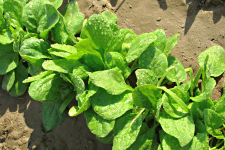English spinach is a leafy green vegetable grown for its masses of leaves which are eaten cooked or raw. The leaves are soft and green and grow to around 30cm tall. If the leaves are picked when they are still young, they are called ‘baby spinach’.
English spinach is an annual and at the end of its life cycle will produce a few tall stems from the centre with small yellow flowers which will drop seeds into the garden. After that, the first plant will die down and new seedlings will probably pop up in the garden.
PLANTING
Choose a spot in the garden which gets around 6 hours of sun every day and prepare the garden bed by removing any weeds and digging some compost into the topsoil. Water the soil and the punnet of seedlings lightly. Use a dibbler or big stick to make small holes about 30cm apart. Gently remove the seedlings from the punnet and place one in each hole. Push the soil around the roots and water them lightly.
English spinach grows really well in pots which are at least 25cm deep. Fill the pot with premium potting mix and water it lightly. Make small holes about 15cm apart and gently place one seedling in each one. Push the soil around the roots and water them lightly.
CARE AND MAINTENANCE
Keep the soil moist by watering every day in summer or every second day in cooler months. Apply liquid fertiliser every two weeks. Watch for aphids, caterpillars, whitefly and snails which can damage the leaves.
HARVESTING
Start harvesting the leaves when they are at least 15cm tall. Use your fingers to break the outer leaves off at the base as this will encourage new leaves to grow from the centre. Wash the leaves to remove any dirt and store in a plastic bag in the refrigerator.
HOW TO EAT
English spinach leaves are delicious cooked in the microwave for just a minute or blanched quickly in a pot of boiling water and served with butter. Use the older leaves to make the scrumptious Spinach Pie in the recipe section in the Smarty Plants Kitchen.
The younger leaves of English spinach can be eaten raw and are fantastic tossed in a salad with tomatoes, cucumber and olives or added to a sandwich instead of lettuce.
HOW THEY GROW
Spinach seedlings have small, soft leaves that look like a miniature version of a mature plant. As the plant grows, the plant produces a lot more leaves on short stalks in a bunch. A small taproot grows under the ground with thin, feeder roots attached which take up the nutrients and moisture that the plant needs.
FAST FACTS
Botanical Name: Spinacia oleracea
Life Cycle: Annual
When to Grow: All year round
Height/Width: 30cm x 30cm
Requirements: Plant in full sun in cooler months and part shade in summer. Water every day and apply a liquid fertiliser every fortnight.
Nutritional Benefits: Spinach is very high in iron, niacin, zinc and dietary fibre.



